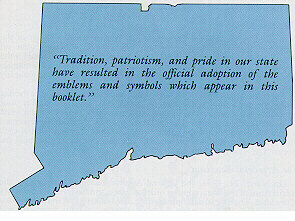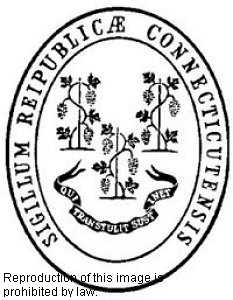Sites, Seals, and Symbols
|
The American Flag
Out of the profusion of designs and symbols inspired by the fervent patriotism and pride of our infant days as a nation, came the flag which is the basis of our present national flag. By 1776 there were many flags for individual military companies and sections of the country and the Continental Congress instructed a committee composed of George Washington, Robert Morris and Colonel George Ross to devise and produce a flag for the United States.
Tradition has it that Betsy Ross, as early as June 1776, made a Stars and Stripes flag from a pencil sketch supplied by Washington. The flag with 13 stripes and 13 stars was officially adopted on June 14, 1777. This was altered to 15 stripes and 15 stars with the admission of Vermont and Kentucky to the Union in 1795.
On April 4, 1818, the final form of our flag was adopted by Congress to allow for the admission of new states. As of July 4, 1960, the flag contains thirteen stripes and fifty stars with each star symbolizing a state.
The State Flag
Inspired by a memorial from the Anna Warner Bailey Chapter of the Daughters of the American Revolution, Governor O. Vincent Coffin, on May 29, 1895, introduced to the General Assembly the first proposal for the adoption of a State Flag. On that same day the Assembly passed a resolution appointing a special committee to prepare a designation of the flag already generally accepted as the official flag of the state.
The General Assembly of 1897 provided an official description of the flag setting the dimensions at five feet, six inches in length and four feet, four inches in width, of azure blue silk, with the armorial bearings in argent white silk with the design in natural colors and bordure of the shield embroidered in gold and silver. Below the shield there is a white streamer, cleft at each end, bordered in gold and browns, the streamer bearing in dark blue the motto "Qui Transtulit Sustinet."
The Armorial Bearings
On March 24, 1931, the General Assembly adopted a design for the official Arms of the State, which it ordered drawn and filed with the Secretary of the State. The official description of the Arms called for: A shield of rococo design of white field, having in the center three grape vines, supported and bearing fruit. Below the shield shall be a white streamer, cleft at each end, bordered with two fine lines, and upon the streamer shall be in solid letters of medium bold Gothic the motto
"QUI TRANSTULIT SUSTINET."
(He Who Transplanted Still Sustains)
The official arms and seal of the State of Connecticut, whether as a reproduction, imprint or facsimile, shall be made and used only under the direction and with the approval of the Secretary of the State.

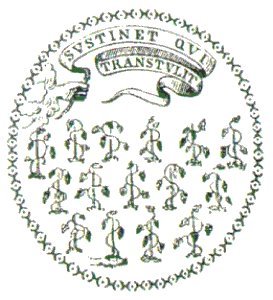 |
The Original Seal Connecticut's first seal was brought from England by Colonel George Fenwick in 1639. It was the seal of the Saybrook Colony and was turned over to the Connecticut Colony at about the time that it purchased the land and fort at Saybrook Point from Colonel Fenwick in 1644. The seal was used by the General Court (General Assembly) from that time forward, but there is no clear record of who had custody of the seal. On October 9, 1662, the same day that the new Royal Charter was read aloud at Hartford, the assembly formally declared that the seal would be kept by the Secretary of the Colony and used as the Seal of the Colony on necessary occasions. It remained the colony's seal until October 1687, when Sir Edmund Andros took control of the colony's government and the seal disappeared. It is presumed to have been destroyed. |
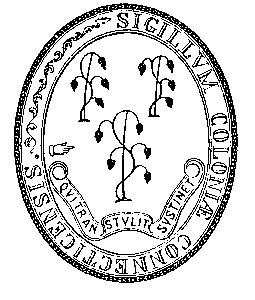 |
The Colonial Seal
Self-government returned to Connecticut in 1689, but for a number of years only a poorly fashioned substitute seal was used. On October 25, 1711, a meeting of the Governor and Council (the upper house of the assembly) resolved, "that a new stamp shall be made and cut of the seal of this Colony, suitable for sealing upon wafers, and that a press be provided with the necessary appurtenances, for that purpose, as soon as may be, at the cost and charge of this Colony, to be kept in the secretary's office." The new, less elaborately decorated seal was larger in size and more oval shaped than the original. The words of the motto remained the same, but the number of grape vines was reduced to three and the legend SIGILLUM COLONIAE CONNECTICENSIS (Seal of the Connecticut Colony) is added to the edge of the seal. The three vines may have been intended to represent the three colonies, New Haven, Saybrook, and Connecticut (Hartford), which, by 1665, had merged to form the Connecticut of that time. |
|
The Great Seal After the conclusion of the Revolutionary War, the inscription on the colonial seal was no longer appropriate. Therefore, in May of 1784 the General Assembly directed the Secretary to alter the inscription to read "SIGILL. REIP. CONNECTICUTENSIS." However, when a new version of the seal was prepared, the inscription contained the words spelled out -- SIGILLUM REIPUBLICAE CONNECTICUTENSIS (Seal of the State of Connecticut). There has been no subsequent alteration to the official state seal. In 1931, the General Assembly required that all representations of the state seal conform to the description in Chapter 54 of the Public Acts of that year. This legislation also prohibited reproduction of the seal except by or under the direction of the Secretary of the State. |
|
The State Motto
The motto "Qui Transtulit Sustinet," (He Who Transplanted Still Sustains), has been associated with the various versions of the seal from the creation of the Saybrook Colony Seal. While the origin of the motto is uncertain, the late Charles J. Hoadly, a former State Librarian, suggested in an article entitled "The Public Seal of Connecticut," which appeared in the 1889 edition of the Connecticut State Register and Manual, that we look to the 80th Psalm as a possible source. "Thou hast brought a vine out of Egypt: thou hast cast out the heathen, and planted it."
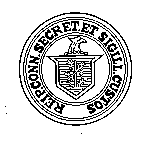 |
Secretary Of The State's Seal The office of the Secretary of the State was created under the Fundamental Orders of 1638/39 and is, therefore, one of the original offices of government in Connecticut. From its inception, the duties of the office of secretary included overseeing elections and the keeping of public records. In 1662 the secretary also became the keeper of the colonial seal. The responsibilities of the office have grown tremendously since that time, but the secretary is still the constitutional and stautory keeper of the public records and the state seal. The motto on the secretary's seal, REIP. CONN. SECRET. ET SIGILL. CUSTOS (Secretary of the State of Connecticut and Keeper of the Seal), is a reflection of the history of the office. |
State Designation (nickname) -- The Constitution State
Connecticut was officially designated the Constitution State by the General Assembly in 1959. As early as the 19th Century, John Fiske, a popular historian from Connecticut, made the claim that the Fundamental Orders of the Connecticut colony adopted in 1638/39 were the first written constitution in history. Some contemporary historians dispute Fiske's analysis. However, Simeon E. Baldwin, a former Chief Justice of the Connecticut Supreme Court, defended Fiske's view of the Fundamental Orders in Osborn's 1925 History of Connecticut in Monographic Form by stating that "never had a company of men deliberately met to frame a social compact for immediate use, constituting a new and independent commonwealth, with definite officers, executive and legislative, and prescribed rules and modes of government, until the first planters of Connecticut came together for their great work on January 14th, 1638-9." The original Fundamental Orders is on permanent display at the Museum of Connecticut History at the Connecticut State Library. The text of the original is reproduced in Section I of the Connecticut State Register and Manual.
Connecticut has also been known as the Nutmeg State, the Provisions State, and the Land of Steady Habits.
|
"The Charter Oak--Charles D. Brownell" (Collection, Wadsworth Atheneum, Hartford). |
|
State Tree The white oak tree (Quercus alba) was designated the State Tree by the General Assembly in 1947. Native to Connecticut, white oaks are slow-growing and long-lived deciduous trees. The most notable features of a white oak are a short stocky trunk three to four feet in diameter, and a rounded canopy between sixty to eighty feet wide. White oaks can grow as tall as one hundred feet and live for hundreds of years. Sometimes mistakenly called the state tree of Connecticut, the famed Charter Oak was a white oak tree. It acquired its name due to the role it played in a dispute between King James II of England and the colony of Connecticut. When King James II ascended to the throne in 1687, he moved to quash the independence of the New England colonies granted by his predecessor. He revoked the colonies’ royal charters and appointed Sir Edmund Andros as governor of a newly-formed Dominion of New England. When Andros demanded the surrender of Connecticut’s charter, the colony’s leaders refused to give it up. Legend holds that during a meeting between Andros and Connecticut’s leaders, with the charter on a table between them, the candle-lit room went suddenly dark. Moments later when the candles were re-lighted, the charter was gone. Captain Joseph Wadsworth is credited with taking the charter and hiding it in the hollow of an ancient white oak tree in Hartford thereafter to be known as the “Charter Oak.” When it fell during a great storm on August 21, 1856, the Charter Oak was estimated to be a thousand years old. It was so revered as a symbol of Connecticut that acorns from the tree were planted throughout the state and a monument was later erected near the site where it stood. |
State Bird
The American Robin
(Turdus migratorius)

The American Robin was adopted as the official State Bird by the General Assembly in 1943. The name Robin is applied to a number of familiar birds, but in North America it is the migratory thrush. (Turdus migratorius.)
Our Robin, a true thrush, is a migratory bird with a reddish-brown or tawny breast and a loud cheery song. It was first called the Robin by the early colonists, in remembrance of the beloved English bird. Despite the protests of some naturalists, we still retain that traditional name.
Familiar, in the summer, throughout North America, the American Robin is seen from Alaska to Virginia. Most people do not know that many Robins spend the entire winter in New England. They roost among the evergreens in the swamps where they feed on winter berries.
State Flower
The Mountain Laurel
(Kalmia latifolia)

Designated as the State Flower by the General Assembly in 1907, the Mountain Laurel is perhaps the most beautiful of Shrubs native to North America. Its fragrance and the massed richness of its white and pink blossoms so vividly contrast with the darker colors of the forests and the fields that they have continually attracted the attention of travelers since the earliest days of our colonization. First mentioned in Captain John Smith's 1624 "General History" of Virginia and New England, specimens were sent in 1750 to Linnaeus, the famous botanist, by Peter Kalm, the Swedish explorer.
Linnaeus gave it the name of Kalmia latifolia, honoring the name of his correspondent and at the same time describing the "wide-leaved" characteristic of the plant. In addition to being called "Mountain Laurel", the plant has also been spoken of as "Calico Bush" and "Spoonwood".
Children's State Flower
Michaela Petit's Four-O'Clocks
(Mirabilis jalapa)

Michaela Petit's Four-O'Clocks, Mirabilis jalapa, were designated the Children's State Flower by the General Assembly in 2015. An herbaceous shrub native to tropical America, Mirabilis jalapa is commonly called the four-o'clock because its fragrant flowers of varied bright colors open around four o'clock every afternoon and close the next morning.
Michaela Petit’s Four-O’Clocks are named in honor of Michaela Petit and trace their roots back to four-o'clocks she and her father planted every year in the garden of their home in Cheshire. In 2007, Michaela, her mother and her sister lost their lives in a home invasion. Michaela was only eleven years old but was already known in her community for her kind heart, her commitment to helping others, and her desire to make the world a better place.
Four-o'clocks taken from Michaela's garden in Cheshire and transplanted by family members after her death bore the seeds to create Michaela's Garden Project, a program designed to honor Michaela by inspiring children to become involved in community service. Through the work of project volunteers, Michaela Petit's Four-O'Clocks bloom in gardens across the state.
State Insect
European Mantis
(Mantis religiosa)

The European "praying" mantis (family, Mantidae, order, Orthoptera) officially became the State Insect on October 1, 1977. The name "mantis", derived from the Greek, originally meant prophet or diviner, and, appropriately, described the mantids' distinctive habit of standing motionless on four hind legs, with the two highly specialized forelegs raised in an attitude of meditation.
The European mantis is not native to Connecticut. Its origin is Northern Africa, Southern Europe, and temperate Asia. These mantids can be found, however, throughout the state from early May or June until the cold weather sets in, when they die rapidly.
Harmless to humans, and averaging 2-21/2 inches in length, this small green or brown insect feeds on aphids, flies, grasshoppers, small caterpillars and moths. Although probably not a significant factor in biological control, mantids are beneficial insects, friends to the farmer, and are, therefore, symbolic reminders of the importance of the natural environment to human and biological survival.
State Animal
Sperm Whale
(Physeter macrocephalus)

The Sperm Whale was designated as the state animal by the General Assembly in 1975. Its selection was made both because of its special contribution to the state's history and because of its ongoing plight as an endangered species.
The Sperm Whale is the largest of the toothed whales, growing up to 60 feet in length and capable of diving over 3,000 feet in search of the squid and cuttlefish on which it feeds. The sperm whale's brain is the largest of any creature ever existing on earth. The white whale in the classic novel, Moby-Dick was a sperm whale.
During the 19th century, Connecticut ranked second only to Massachusetts as a whale hunting state. The sperm whale was the species most sought after by Connecticut whalers circling the globe on ships out of New London, Mystic and other Connecticut ports to bring back needed oil for lamps and other products.
State Mineral
The Garnet
(Almandine garnet)
Fe3Al2Si3O12
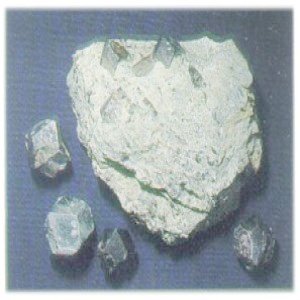
Connecticut is one of the finest sources in the world of the almandine garnet, named the State Mineral by the 1977 General Assembly. An ancient gem, it was named "garnata" in the 13th century by Albertus Magnus, and was known as the "Carbuncle", likening it to a small, red hot coal.
The garnets are actually a group of similar minerals, complex silicates of the same atomic structure, but differing in chemical composition. They vary in color from pale to dark tints, including the deep violet-red of the almandine garnet.
This mineral's significant hardness, 7 on the Mohs scale, has made the garnet, as an abrasive, important industrially throughout Connecticut's history. It contributed to this development by providing the base for grinding wheels, saws, and the better cutting quality of garnet paper, a variety of sandpaper.
State Shelfish
Eastern Oyster
(Crassostrea virginica)
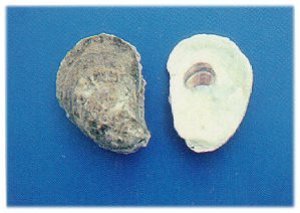
The Eastern oyster was designated as the State Shellfish by the General Assembly in 1989. The oyster, which is a bivalve mollusk, occurs naturally in Connecticut's tidal rivers and coastal embayments and is cultivated by the oyster industry in the waters of Long Island Sound.
Oysters were consumed in great quantities by Connecticut's Native American inhabitants, and early European settlers found oysters to be a staple and reliable food source. The first colonial laws regulating the taking of oysters in Connecticut appeared in the early 1700's.
Oyster farming developed into a major industry in the State by the late 19th century. During the 1890's, Connecticut held the distinction of having the largest fleet of oyster steamers in the world.
Today, Connecticut's oyster industry continues to thrive. Annually, thousands of bushels of these delicious Connecticut grown mollusks are marketed throughout the country. Of all the shellfish species associated with the Connecticut shoreline, the oyster is by far the best known for its colorful history, continued economic importance and esteemed reputation for quality.
State Fish
American Shad
(Alosa sapidissima)

(U.S. Fish and Wildlife Service, Duane Raver artist.)
Native to Connecticut and eastern coastal waters, the American shad was designated the State Fish by the 2003 General Assembly. Shad are anadromous fish, spending most of their lives in the ocean and annually returning to their natal fresh water rivers to reproduce.
Ocean-dwelling adults have forked tails, metallic blue-green colored backs, silvery sides, and an abdominal ridge of sharp modified scales called scutes. The American shad is the largest member of the herring family. Its scientific name, Alosa sapidissima, means "most delicious shad."
Historically, American shad meat and roe were important food sources for Connecticut's Native American population and European colonists. During the 19th century, shad fishing became a major Connecticut industry. But by the 20th century, dam construction, over fishing and river pollution had severely reduced the Atlantic Coast shad population.
Today, shad restoration efforts are underway in eastern coastal rivers. With an annual spring migration of more than a million American shad, supporting commercial and sport fishing, as well as shad derbies and festivals, the Connecticut River's restoration program is one of the most successful.
State Dinosaur
Dilophosaurus

© N. Tamura. CC BY 3.0 via Wikimedia Commons
https://creativecommons.org/licenses/by-sa/3.0/deed.ens
The Dilophosaurus, a bipedal carnivorous therapod that lived 190 million years ago, was designated the state dinosaur by the General Assembly in 2017. No fossilized bones of Dilophosaurus have been found in the state, but 2,000 three-toed fossilized footprints preserved in Connecticut’s Dinosaur State Park are believed to have been made by these dinosaurs.
Dilophosaurus was the largest known North American land-dwelling dinosaur of the Early Jurassic period. Standing upright on its hind legs, Dilophosaurus was approximately six feet tall and twenty feet long and weighed up to 1,000 pounds.
The scientific name Dilophosaurus, meaning “two-ridged-lizard," is taken from the two boney crests that sat atop the dinosaur’s skull. The purpose of the crests is not clear, but some paleontologists think they may have been a visual display feature used to attract a mate.
State Fossil
Eubrontes giganteus

The Connecticut Valley is one of the world's foremost dinosaur track localities. Many different types of fossil track impressions have been found in the Valley's sandstones of the early Jurassic Period (200 million years ago). Eubrontes, a large three-toed track, was designated the State Fossil in 1991. Although no skeletal remains of the specific track-making dinosaur have been found, the shape, size, and stride of Eubrontes indicate that the animal was a carnivorous dinosaur approximately eighteen feet in length, and was closely related to the western genus Dilophosaurus. Two thousand Eubrontes tracks were discovered on a single layer of rock in Rocky Hill, in 1966, and subsequently Dinosaur State Park was created for their preservation and interpretation. This Registered Natural Landmark site receives visitors from throughout the world.
State Ship
USS Nautilus (SSN-571)

Built by Connecticut craftsmen, USS Nautilus was the world's first nuclear powered submarine and logged more than 500,000 nautical miles during her distinguished 25 year career. The USS Nautilus, named Connecticut's State Ship by the 1983 General Assembly, has been designated a National Historic Landmark and is permanently berthed next to the Submarine Force Library and Museum at Goss Cove in Groton.
State Flagship and Tall Ship Ambassador
Freedom Schooner Amistad
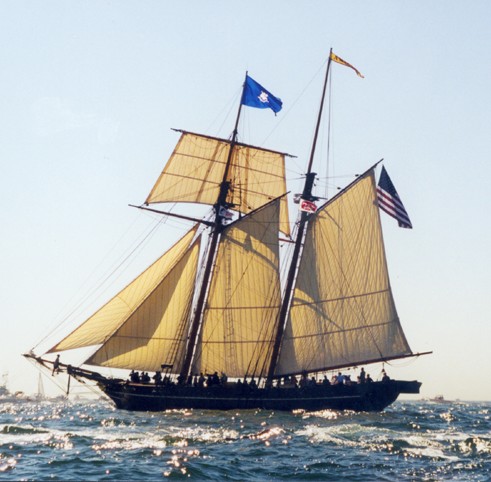
(State of Connecticut, Nina Ritson photographer.)
Freedom Schooner Amistad, a recreation of the 19th century vessel Amistad, constructed at Connecticut’s Mystic Seaport, was designated the State Flagship and Tall Ship Ambassador by the General Assembly in 2003. Setting sail in the year 2000, Freedom Schooner Amistad has taken the story of the Amistad Incident of 1839—and its lessons of leadership, perseverance, cooperation, justice, and freedom—to both national and international communities.
The Amistad Incident of 1839 began when a group of Africans kidnapped from Mendi to be sold as slaves revolted aboard the schooner Amistad during transport from Havana to Puerto Principe, killing the captain and taking control of the vessel. They ordered the schooner’s navigators to sail to Africa, but they navigated north and west instead. Eventually, the Amistad was sighted near Long Island, seized by the Navy, and towed to New London Harbor.
Imprisoned on charges of murder, the Africans were soon engaged in a second battle for freedom that brought the first civil rights case to be heard before the U.S. Supreme Court. After winning their appeal, the majority of the captives returned to their homeland in November 1841.
State Aircraft
F4U Corsair

Named the State Aircraft in 2005, the F4U Corsair was designed and built in Connecticut by the men and women of United Aircraft Corporation and its operating divisions. Often considered the finest American fighter plane of World War II, the Corsair continued in U.S. military service through the Korean War.
Equipped with Hamilton Standard's largest propeller, and Pratt & Whitney's most powerful air-cooled engine housed in a durable, streamlined Vought-Sikorsky airframe, the prototype F4U took flight on May 29, 1940. It was the first American single-engine fighter to top 400 mph.
Dubbed the "Bent-Wing Bird"--a reference to its distinctive inverted gull wing design--the F4U Corsair debuted in combat in 1943. Flown by Marine Corps and Navy pilots in the Pacific Theater, the powerful and versatile fighter played a decisive role in the air war, assisted ground forces with bombing and close air support capabilities, and protected the Pacific Fleet from kamikaze attacks.
State Pioneering Aircraft
Gustave Whitehead's No. 21
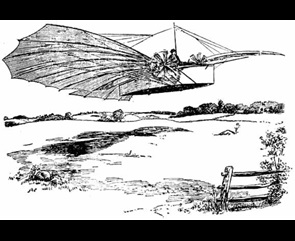
Via Wikimedia Commons
In 2013, the General Assembly designated Powered Flight Day as a day to honor the first flight by aviation pioneer Gustave Whitehead, a Bavarian immigrant and Bridgeport resident, and to commemorate the Connecticut aviation and aerospace industry.
In 2017, the General Assembly additionally recognized Whitehead’s contributions to the birth of aviation by designating his No. 21 flying machine as the State Pioneering Aircraft. The No. 21, also called “The Condor,” was designed and fully constructed by Whitehead himself. It was a 16 foot long monoplane with a boat-like body and bat-like wings made of silk attached to bamboo ribs. A mechanic by trade, Whitehead also engineered and built two innovative acetylcholine-fueled engines for the No. 21: one to power the aircraft’s propellors in flight; and the other to drive the wheels for ground running to takeoff speed.
After several test flights made over the summer of 1901, Whitehead made the first successful powered flight in the No. 21, in Fairfield on August 14, 1901.
State Hero
Nathan Hale, 1755 - 1776

In 1985, the General Assembly designated Nathan Hale to be Connecticut’s State Hero. Born in Coventry, and educated at Yale University, Hale served as a school master until he joined the Connecticut militia to fight for independence from Britain. He was as commissioned a Captain in the Continental Army in 1775 and, in September of that year, at General George Washington’s request for
a volunteer, Nathan Hale crossed enemy lines to gather information as to the strength and plans of the British. Caught while returning, he was hanged as a spy on September 22, 1776, without benefit of a trial.
The Patriot’s dedication to our country is enshrined in the immortal words “I only regret that I have but one life to lose for my country.”
The Hale Homestead, located at 2299 South Street in Coventry, is listed on the National Register of Historical Places.
State Heroine
Prudence Crandall 1803-1890
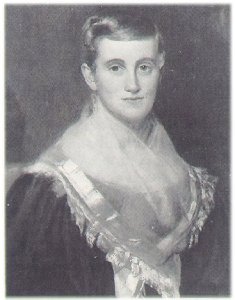
(Photograph courtesy of the
In 1995, the General Assembly designated Prudence Crandall to be Connecticut’s State Heroine.
In 1833, Prudence Crandall established the first academy for African-American women in New England. During its 18 months of operation, Crandall and her students faced hardships, violence, and harassment from town residents. She was jailed, placed on trial twice and convicted for breaking a law specifically designed to close down her school. Two months after the state Supreme Court overturned her conviction and dismissed the case against her, a mob attacked the school at night, breaking windows and attempting to set it on fire with the students and Crandall inside Fearing for her students’ safety Crandall decided to close the school.
Prudence Crandall demonstrated great courage and moral strength by taking a stand against prejudice. Her home in Canterbury, located at the intersections of state routes 14 and 169, is a National Historic Landmark.
State Song
"Yankee Doodle"
|
VERSE
|
CHORUS
|
Second State Song
"Beautiful Connecticut Waltz"
| VERSE Beautiful Connecticut Waltz. Play it over again. Your rivers and streams Flow through my dreams. I’m hoping it never would end.
|
CHORUS
|
State Folk Dance
The Square Dance was named the official State Folk Dance by the General Assembly in 1995.
State Polka
The Ballroom Polka was designated the official state polka by the General Assembly in 2013.
State Cantata
"The Nutmeg"
In 2003, the General Assembly designated "The Nutmeg" by Stanley L. Ralph, as the official State Cantata. A cantata is musical composition consisting of choruses, solos, recitatives and interludes, the lyrics often based upon a story or poem. "The Nutmeg" tells Connecticut's history through song. It was first performed in 1962 and was specifically written for the voices of junior high school students.
State Poet Laureate
The current (2022-2025) Connecticut Poet Laureate is Antoinette Brim-Bell of West Haven.
State Troubadour
The current (2022-2025) State Troubadour is Kala Farnham of Pomfret Center.
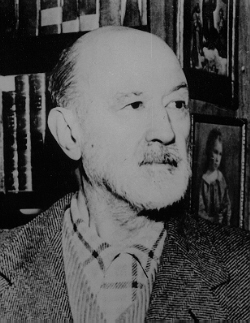 |
State Composer
|
State Composer Laureate
Jacob Druckman of Milford (1928-1996) was designated the Charles Edward Ives Memorial Composer Laureate of the State of Connecticut in 1993 by the directors of the Charles Ives Center for the Arts.
State Tartan

(Courtesy of the Connecticut State Library, Information Services Department)
In 1995, the General Assembly adopted an official tartan for the state. It is a plaid, the colors and design representing notable features of Connecticut's physical geography: Large blue stripes for Long Island Sound, medium gray stripes for granite, large green stripes for forests, red and yellow pinstripes for autumn leaves, and white pinstripes that are offset from the center, representing the state's unpredictable winter snowfall.
The State Tartan's thread ratio is blue-10, gray-2, white-1, gray-5, green-8, yellow-1, green-2, red-1, green-8, gray-8 and blue-10. (State Tartan image courtesy of the Connecticut State Library, Information Services Division.)
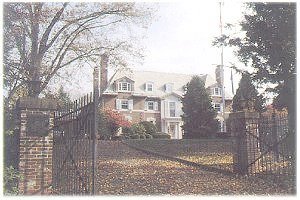
The Executive Residence
Georgian Colonial in design, the Executive Residence is located on six beautifully landscaped acres, at 990 Prospect Avenue, overlooking the city of Hartford. The furniture and decorations of the nineteen-room governor's residence are 18th Century originals and reproductions.
The residence was built in 1909 by Dr. George C. F. Williams, who occupied it until 1933. The original cost of the development of the property was $300,000. It was purchased by the State in 1943 for $38,928, after inspection of 38 different pieces of property by the Legislative Committee on the Executive Residence.
Governor Raymond E. Baldwin and his family first occupied the residence on September 14, 1945. The formal public opening ceremonies were held on October 18, 1945.
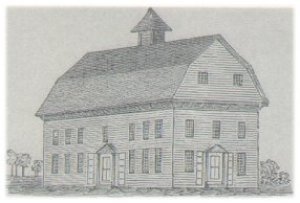 The First State House
The First State House
The first State House in Hartford served from 1720 until 1796, when the adjacent and recently completed Old State House opened. Earlier buildings occupied the site, but this was the first structure built as a state house. The square was laid out in 1636 with the founding of Connecticut and city of Hartford. The Fundamental Orders of 1638/39 were ratified on this site. In 1687, the Charter of 1662 was stolen from this site and hidden in the Charter Oak Tree. Here General Washington first met Rochambeau and the French armies in America, and planned the Yorktown strategy. And, it is here that Connecticut delegates gathered to consider ratification of the U.S. Constitution. In 1783, a watchman dropped a lighted candle and the building partially burned. As a consequence of the damage caused by the fire, the present Old State House was built.
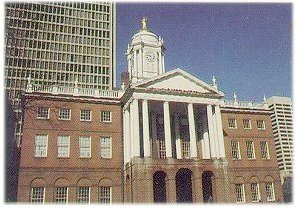 The "Old" State House
The "Old" State House
Designed by Charles Bulfinch and built in 1796, the Old State House is one of the nation's oldest state houses.
The building opened in May of 1796. Oliver Wolcott, signer of the Declaration of Independence was the first Governor to serve here. The building was the seat of state government until 1878, when the present Capitol was opened.
Major state and national events have, and continue to occur at the Old State House. Lafayette was made a citizen here, many American presidents, including Jackson, Monroe, Johnson, Ford and Bush have visited. Here in 1981, President Carter gave the U.S.S. Nautilus to Connecticut. The trials of Cinque and the Amistad opened here in 1839. P.T. Barnum served in the legislature here, and notables such as Mark Twain, Charles Dicken, Samuel Colt and Harriet Beecher Stowe visited the building.
The Old State House is a registered National Landmark and open to the public year-round. The restored historic chambers, the restored grounds are daily filled with events, exhibitions, concerts, cannon firings, tours and a full museum store.

The State Capitol
Overlooking Hartford's 41 acre Bushnell Memorial Park, the Connecticut State Capitol first opened for the General Assembly in January, 1879.
Initial work on the project had begun eight years before in 1871 when the legislature established a special commission and appropriated funds for construction of a new statehouse. The site was contributed by the city of Hartford, and the commission retained James G. Batterson to build the Capitol from plans designed by noted architect Richard M. Upjohn.
Constructed of New England marble and granite and crowned by a gold leaf dome, the Capitol was built at a cost of $2,532,524.43 and has an estimated replacement value of more than $200,000,000.
In addition to housing the State Senate Chamber, Hall of the State House of Representatives and offices of the Governor, Lieutenant Governor and Secretary of the State, the statehouse and surrounding grounds abound with memories and mementos of Connecticut's early years.
The Connecticut State Capitol was declared a national historical landmark by the United States Department of Interior in 1972.


